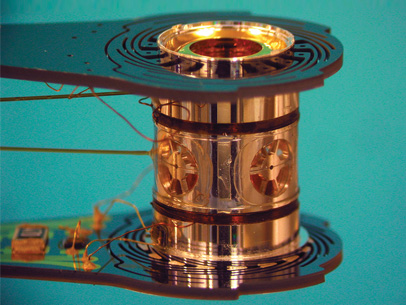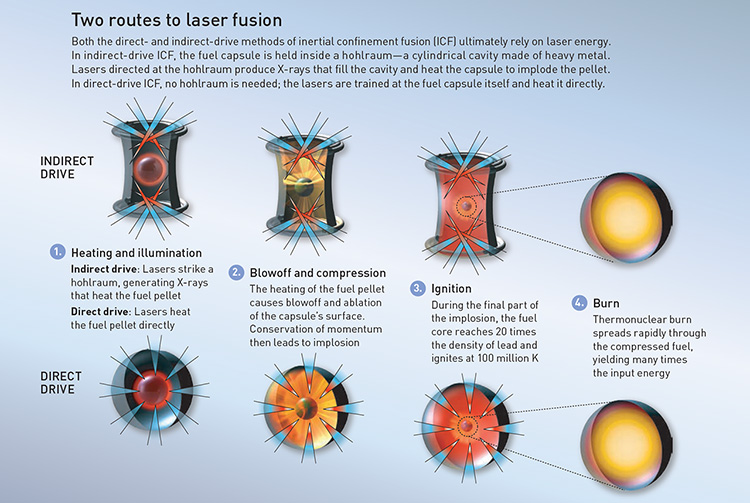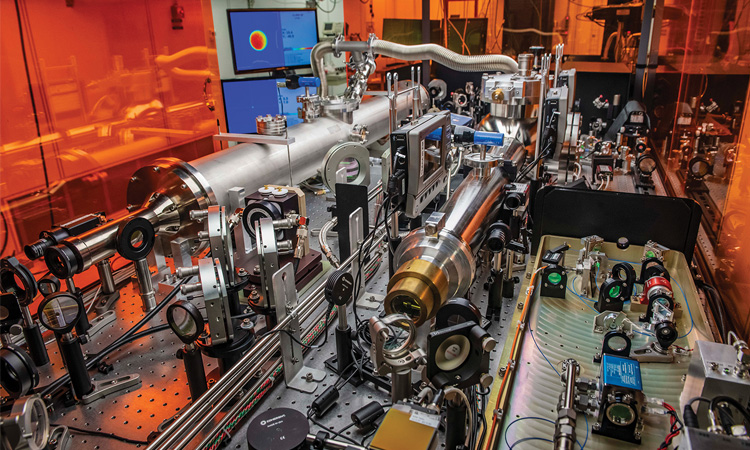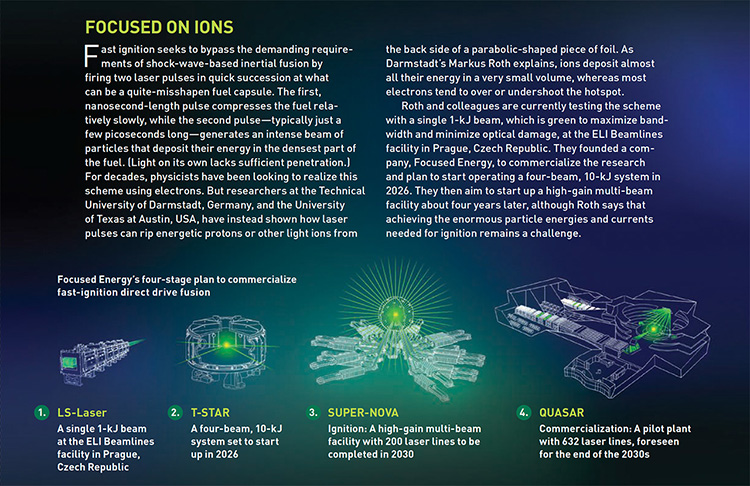 The US Naval Research Laboratory’s Electra argon fluoride laser. [J. Steffen, US Navy]
The US Naval Research Laboratory’s Electra argon fluoride laser. [J. Steffen, US Navy]
On 5 December 2022, physicists working on the National Ignition Facility (NIF) at the Lawrence Livermore National Laboratory (LLNL), USA, recorded a huge burst of neutrons in their experimental detectors. NIF is the world’s biggest laser, and it generates fusion reactions by rapidly imploding pellets of hydrogen isotopes using exceptionally intense, energetic flashes of light. The deluge of neutrons signaled that the researchers had, after many years of trying, finally achieved “ignition”—producing about 1.5 times more energy than was present in the laser pulse.
The achievement led to renewed optimism that fusion might yield the ultimate in energy solutions—an abundant, green, baseload source of electricity that creates no long-lived radioactive waste. But although scientists hailed the result, some were unconvinced that NIF would provide the technology for a working fusion power plant.
 NIF’s lasers only illuminate a target’s poles, allowing them to enter openings at each end of a hohlraum (above). [LLNL]
NIF’s lasers only illuminate a target’s poles, allowing them to enter openings at each end of a hohlraum (above). [LLNL]
NIF relies on “indirect-drive” fusion, which involves crushing fuel pellets with X-rays produced by directing the facility’s 192 laser beams at a gold can, or “hohlraum,” surrounding the pellet. This approach has its virtues, notably that the X-rays help make the implosion smoother. But many scientists argue that the vast amount of energy lost in generating the X-rays—some three-quarters of the total—makes the scheme a non-starter for harnessing the fusion yield in a commercial power plant.
These experts instead advocate the conceptually simpler “direct drive.” This involves training laser beams at the fuel capsule itself, in principle transferring much more of the laser’s energy to the nuclear fuel while making the target simpler. There is no need for a hohlraum, and the capsules could potentially be fabricated using cheaper techniques and materials.
Research in this area has been limited to small targets producing low fusion yields. But scientists are increasingly optimistic that direct drive can be made to work, partly because of the growing interest in fusion energy among governments and especially in the private sector. Plus, as Riccardo Betti of the University of Rochester, USA, notes, laser technology has made huge strides in recent years—particularly the ability to operate at very high bandwidths. That technology, he reckons, “can be a game changer” for fusion energy
Scientists are increasingly optimistic that direct drive can be made to work, partly because of the growing interest in fusion energy among governments and especially in the private sector.
Exploiting inertia
Harnessing fusion energy involves confining a plasma of light nuclei—usually deuterium and tritium—at such high temperatures that the nuclei overcome their mutual repulsion and fuse, giving off energy. If the plasma can be held at high enough densities for long enough, then energetic reaction products (alpha particles) deposit enough heat to yield a self-sustaining burn—generating ignition and multiplying the output many times over.
Physicists have followed two different strategies to achieve this. One attempts to maximize confinement time, holding a fairly rarefied plasma inside a large chamber using powerful magnets. The other instead creates exceptionally high densities for a fleeting moment.
It is in pursuit of this second approach, known as inertial confinement fusion, that high-power, high-energy lasers are employed. The idea is to fire laser pulses from all directions at a tiny fuel pellet such that the pellet’s outer layer is blasted off, and conservation of momentum then forces the rest inward at enormous speeds (the light on its own not providing enough radiation pressure).
 [Enlarge graphic] [Illustration by Phil Saunders]
[Enlarge graphic] [Illustration by Phil Saunders]
As implied by the technique’s name, the capsule’s inertia provides the opportunity for fusion—the tiny fraction of a second between implosion and re-explosion when the temperature and pressure in the plasma created by the pellet are high enough to initiate fusion reactions. The reactions first take place in a small central region of the compressed plasma known as the hotspot and then, with sufficient heating by alpha particles, spread to the rest of the relatively cold fuel.
Scientists at LLNL started research on inertial fusion in the early 1970s. They initially planned to pursue direct drive but soon realized that they couldn’t achieve the uniform illumination needed for symmetrical, high-yield implosions. So they switched to indirect drive and have used it ever since as experimental input to the computer simulations used to maintain America’s nuclear weapons. Having failed to achieve ignition as originally envisaged in 2012, they finally succeeded last year, yielding 3.15 MJ from 2.05 MJ of laser energy.
Some researchers at other labs have instead persisted with direct drive. In doing so, they have faced a number of damaging instabilities created when incoming laser beams interact with the plasma. One of these, cross-beam energy transfer, is due to beams interacting in the plasma and driving a sound wave, which can transfer energy from an incoming beam to an outgoing one. That reduces the pressure of the implosion.
Another problem occurs when electrons in the plasma are accelerated by oscillations in the electron density, again set up by the propagating laser beams. These electrons can penetrate the core of the capsule and heat up the fuel prematurely. The extra heat impedes compression, making it harder to reach the extreme conditions needed for ignition.
According to Betti, plasma instabilities can be eliminated if the laser light has a high enough bandwidth—implying very limited coherence. A bandwidth of 10 terahertz (THz = 1012 Hz) equates to a coherence time of just 10–13 s—shorter than the period of the fastest plasma oscillations.
Glass vs. gas
A leading center for direct-drive research is the University of Rochester’s Laboratory for Laser Energetics (LLE). This is home to the OMEGA laser, which uses 60 beams from neodymium-doped glass amplifiers to deliver 30 kJ of energy and 30 TW of power onto fuel pellets measuring less than a millimeter across. These experiments have created a plasma producing fusion energy up to about 3% of the laser’s energy, although the latter is too low to be able to confine alpha particles efficiently and thereby significantly self-heat the plasma.
 Part of the University of Rochester’s fourth-generation laser for ultra-broadband experiments (FLUX), which will increase the bandwidth of the Laboratory for Laser Energetics’ OMEGA laser to mitigate laser–plasma instabilities during inertial fusion experiments. [Laboratory for Laser Energetics / University of Rochester]
Part of the University of Rochester’s fourth-generation laser for ultra-broadband experiments (FLUX), which will increase the bandwidth of the Laboratory for Laser Energetics’ OMEGA laser to mitigate laser–plasma instabilities during inertial fusion experiments. [Laboratory for Laser Energetics / University of Rochester]
OMEGA’s performance is hindered in part by the laser’s bandwidth. It uses thick non-linear crystals to convert the laser’s near-infrared radiation to more useful ultraviolet frequencies, but the crystals restrict bandwidth to below 1 THz. In response, researchers have been working on a project called the fourth-generation laser for ultra-broadband experiments (FLUX). This aims to increase bandwidth to between 10 and 15 THz by using a novel combination of optical parametric amplification and sum-frequency-generation to up-convert very broadband infrared pulses into similarly broadband, high-energy ultraviolet pulses.
Having demonstrated the technology in a tabletop experiment, the researchers are now installing a new pump laser and beamlines at OMEGA to generate broadband pulses with 150 J. Jonathan Zuegel, head of laser development at LLE, says that experiments with FLUX should start in 2024 and that its ability to suppress laser–plasma instabilities should be demonstrated by the end of 2025. At that point, he says, assurance of the ability to ignite a target should “take a spike from very confident to proven.”
 The final mirror array inside the Nike laser facility at the US Naval Research Laboratory. [US Naval Research Laboratory]
The final mirror array inside the Nike laser facility at the US Naval Research Laboratory. [US Naval Research Laboratory]
At the Naval Research Laboratory (NRL), USA, other researchers have been working with a very different type of laser—one made from argon fluoride gas. According to Stephen Bodner, former head of the lab’s laser-fusion program, argon fluoride has a number of major advantages over glass. It has a naturally large bandwidth of around 10 THz. It also has a short wavelength—193 nm compared with glass’s 351 nm—which allows it to penetrate to higher plasma densities and thereby deposit more energy in fusion reactions.
Despite its appeal for inertial fusion and some initial experiments in the early 1980s, argon fluoride was abandoned for many years due to fragile pulsed-power supplies and damaged optics. But Bodner and colleagues persisted with gas lasers, using the slightly longer-wavelength and less-troublesome krypton fluoride. From 1995 onward, they employed NRL’s Nike facility to focus 3-kJ pulses onto planar targets, showing that they could “zoom” in the spot of illuminating light during implosion to make best use of the laser energy.
Encouraged by the semiconductor industry’s widespread use of argon fluoride for lithography, NRL scientists converted the lab’s Electra facility from krypton fluoride to argon fluoride to demonstrate efficient and high repetition-rate pumping with electrons. Electra does not fire beams at a target, as its job is to improve laser performance. Its output is still very modest, but it nevertheless achieved a world record for argon fluoride lasing in 2020, reaching about 200 J.
With current laser systems falling far short of ignition, much work remains to be done on direct drive—and many opinions exist as to the best way forward.
Pros and cons
With current laser systems falling far short of ignition, much work remains to be done on direct drive—and many opinions exist as to the best way forward. Vladimir Tikhonchuk, a plasma and fusion physicist at the University of Bordeaux, France, believes that eventually, gas lasers could provide more robust, round-the-clock operation than glass amplifiers, given the latter’s susceptibility to laser damage. But he argues that glass lasers are currently “well, well ahead.” One problem with gas, says Tikhonchuk, is the need for a long pump pulse to extract energy from the much bigger laser volume. Overcoming the temporal mismatch that then results between pump and signal pulses involves feeding the latter through the laser amplifier one after another. To ensure that those pulses all arrive at the target simultaneously, a system of mirrors delays the earlier ones. “This multiplexing technique makes things more complicated,” he says.
Bodner downplays the problem, insisting that the extra space and complexity are “not a big deal.” He argues that glass lasers face the real problem—a non-linear dependence of their refractive index on light intensity. This, he claims, impedes the reduction of waves’ coherence time needed to smooth out a beam’s intensity variations. Zuegel, in contrast, maintains that coherence time simply scales inversely with laser bandwidth.
Scientists also fail to agree on the potential of different implosion schemes. Like NIF, direct-drive lasers can use a single laser pulse to compress and heat a capsule, with the hotspot created by a shock wave set up inside the imploding fuel. But they can also employ twin pulses—using the first to compress the pulse with relatively little power, and the second, shorter pulse to heat the fuel via an additional shock wave.
Known as “shock ignition,” the latter scheme promises to increase the gain for a given laser energy—NRL researchers think it could push an argon fluoride laser’s gain to 160. But Bodner argues that the Rochester group will not be able to realize this advantage because, although Betti invented the technique, glass lasers cannot produce short pulses with sufficient power. Betti disagrees, arguing that OMEGA can circumvent its power limitations by using smaller targets, and insists that demonstrating symmetrical implosions is what really counts, not the short second pulse.
Another concept that uses separate laser pulses to heat and compress the fuel is “fast ignition.” Rather than setting up shock waves inside the capsule, the idea here is to heat the fuel directly from outside. This in principle relaxes symmetry requirements and saves laser energy, but creates major headaches of its own (see “Focused on ions,” below).
 [Enlarge graphic] [Adapted from Focused Energy]
[Enlarge graphic] [Adapted from Focused Energy]
The road to ignition
Despite their differences of opinion, all involved in research on direct drive agree that more data are needed—particularly those from experiments rather than computer simulation.
Higher-energy data could be collected at NIF, which has been used for direct-drive research for years. But as LLNL’s chief scientist for inertial-confinement fusion Omar Hurricane points out, the facility is not ideal. Since the lasers are set up for indirect-drive research, they only illuminate a target’s poles. Hurricane says that a study group considered setting up spherical illumination, but found that it would be very expensive and put NIF out of action for several years. He adds that there appears to be no “momentum in this direction.”
What is needed instead, according to Tikhonchuk, is a brand-new purpose-built laser. This, he says, could have an energy of about 1 MJ and an energy gain of 10, and could fire several shots an hour—NIF does one high-yield experiment per week at most. It might only be a half or a third the size of NIF, he estimates, but would still cost US$1−$2 billion. “If you want to go the next step, we need another installation,” he says. “People understand that, but it is an investment.”
Zuegel is confident that LLE can build a next-generation facility for less than US$1 billion, but he is not certain it will reach ignition. He says that the tentatively named OMEGA Next will probably achieve high bandwidths by temporally multiplexing FLUX-type beams into many different wavelengths. He notes that discussions about the energy the new laser will have are ongoing, but he foresees construction starting around 2030 and operations by about the middle of the decade.
Physicists in Europe, meanwhile, are looking to revive an ignition-scale project known as the European High Power Laser Energy Research Facility (HiPER). The proposal was abandoned following NIF’s initial failure to achieve ignition in 2012 as envisaged and disagreements over which implosion scheme to use. But proponents have now agreed on shock ignition, and Tikhonchuk says that the revamped facility, costing perhaps a few billion euros, could be up and running within 10 to 15 years.
Researchers working on argon fluoride also intend to commercialize fusion energy. Former NRL fusion program head Stephen Obenschain in 2022 set up the company LaserFusionX to realize a multi-phase plan. The firm aims to develop a single 30 kJ beamline, then build and operate multiple beamlines to demonstrate ignition and an energy gain of at least 100, before finally constructing a pilot power plant—all for a cool US$5−$6 billion, excluding inflation.
 The power flow in a hypothetical fusion-energy pilot power plant exploiting a 650 kJ argon fluoride laser operating at 10 pulses per second and generating an energy gain of 160 via a shock-ignited target. [J. Bates and S. Obenschain]
The power flow in a hypothetical fusion-energy pilot power plant exploiting a 650 kJ argon fluoride laser operating at 10 pulses per second and generating an energy gain of 160 via a shock-ignited target. [J. Bates and S. Obenschain]
Light in the fast lane
Of the various proposals, it remains to be seen how many can attract the necessary funding. All foresee a mixture of public and private funding. Obenschain, for example, aims to rely on private money for LaserFusionX’s core fusion technology, although he hopes the US Department of Energy will pay to overcome some of the vast obstacles to a power plant.
To generate the several hundred megawatts of electricity needed to be competitive, a fusion-energy power plant would have to fire laser shots perhaps ten times a second.
To generate the several hundred megawatts of electricity needed to be competitive, such a plant would have to fire laser shots perhaps ten times a second. That would require not only lasers that operate efficiently at high repetition rates, but also cheap and mass-produced targets, a system for positioning those targets rapidly and accurately, a tritium production process, and radiation-resistant materials for lining the target chamber.
Regarding the lasers themselves, both glass and gas advocates think they can achieve the efficiencies needed—15%–20% for the former and around 10% for the latter, combined with a higher gain. But both face pumping challenges. Argon fluoride lasers depend on complex pulsed-power generators, while glass or other solid-state lasers require diodes, which are much more efficient than traditional flashlamps but are currently far too expensive.
Given the “phenomenal” scale of the challenge, Peter Norreys, Oxford University, UK, believes it wise to keep all options open. One possibility, he says, is to build a much bigger laser—up to 20 MJ—to research multiple concepts spanning both direct and indirect drive. He concedes that this would be extraordinarily expensive, perhaps around US$40 billion, and adds that it might require an intergovernmental organization like that running CERN in Switzerland.
Hurricane shares Norreys’ caution, arguing that it is still too early to “choose a winner for fusion energy applications”—whether direct or indirect drive. Indeed, he reckons it will probably still be “many decades” before fusion energy becomes economically viable, if it ever does.
But plenty are willing to take what Norreys describes as the “high-risk, high-reward” road to fusion energy. Indeed, California firm Longview Fusion Energy Systems claims that with indirect-drive technology based on NIF’s target design, it will supply 50 MW to the electrical grid by 2035.
Those looking to commercialize direct-drive technology are fractionally less bold, but still have very ambitious time horizons. Markus Roth, a professor at TU Darmstadt and chief science officer of fast-ignition company Focused Energy, foresees a pilot plant by the end of the 2030s. Obenschain, meanwhile, envisages “standing start to a pilot plant in 16 years”—an optimism for which he is unapologetic. “I think you have to be optimistic to be in this field,” he says.
Edwin Cartlidge is a freelance science writer based in Rome, Italy.
For references and resources, visit: optica-opn.org/link/0623-directdrive.

